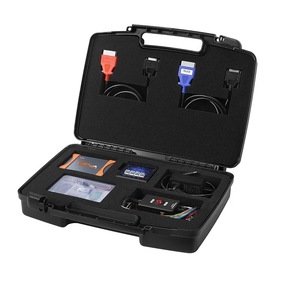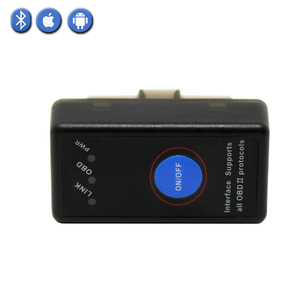(1377 products available)












































































































































































































Engine Control Unit (ECU) Programmers
These are handheld devices or software that allow access to the car's ECU. They are used to install custom tunes, modify existing parameters, or revert to stock settings. Their primary role is to optimize engine performance, increase fuel efficiency, or ensure compatibility with aftermarket parts. ECU programmers come in various types:
Plug-and-Play: These devices connect directly to the car's OBD-II port, allowing for quick tuning and diagnostics without extensive installation.
Lap Top-Based: This type of ECU programmer requires a laptop to communicate with the vehicle's ECU. It allows for more advanced tuning and data logging capabilities.
Custom Tuning: Some ECU programmers come with pre-loaded tunes tailored to specific vehicles and aftermarket setups. These tunes can be installed or modified further using a laptop.
Chassis Dynamometers
Chassis dynamometers measure the power and torque output of a vehicle's wheels, allowing programmers to understand better its performance characteristics. This data is critical when developing or refining ECU tunes to achieve desired performance metrics. Moreover, chassis dynamometers simulate various driving conditions and loads, enabling comprehensive testing of a vehicle's performance under different scenarios.
OBD-II Scanners and Programmers
These are essential tools for accessing and communicating with a car's onboard diagnostic system. They serve multiple purposes, including reading and clearing diagnostic trouble codes (DTCs), monitoring real-time data from various sensors, and programming certain vehicle parameters. OBD-II scanners and programmers come in various types:
Handheld Scanners: These portable devices plug into the OBD-II port and provide a user-friendly interface for diagnostics and data monitoring.
Bluetooth Adapters: These small devices connect to the OBD-II port and communicate with a smartphone or tablet via Bluetooth. They enable app-based diagnostics and real-time data monitoring.
VIN-Specific Programming Tools
Some manufacturers require unique programming tools to program keys, modules, or other components specific to the vehicle's VIN. These tools ensure compatibility and security when working with critical vehicle systems.
Car computer programmers have various specifications and requirements that must be met to ensure safe and effective use. Here are some of them:
Power Supply
Car computer programmers require a stable power supply to function properly. If the battery is low, it could affect the functioning of the car's computer. Some programmers have power management features that allow them to draw power from the battery without draining it.
Compatibility
Different car models use different types of computer programmers. For instance, a car that was manufactured recently will probably have a different programmer than one that was manufactured several years back. Therefore, it is important to ensure that the car computer programmer is compatible with the make and model of the vehicle.
Security
Security is a key consideration for car computer programmers. If a hacker gains access to the car's computer system, they could perform malicious activities such as stealing the car or tracking its location. To enhance security, some car computer programmers use encryption to prevent unauthorized access.
Memory
Car computer programmers have different memory capacities, which determine how much data they can store. The memory size required depends on the type of tasks being carried out. For example, if the task involves programming keys, a higher memory capacity will be needed to store the key data.
Maintaining a car computer programmer is important to ensure optimal performance and longevity. Here are some maintenance tips:
There are several factors to consider when buying car computer programmers, including:
Functionality
Different car computer programmers have varying functions. Some have basic functions like reading and clearing error codes while others have advanced functions like programming keys and coding new modules. Depending on the shop's needs, it is important to consider a car computer programmer with the desired functions.
Vehicle coverage
Some car computer programmers are only designed to work with specific cars, especially those with OBD II ports. Others can handle a wide range of vehicles, including trucks and motorcycles. For a better experience, consider a car computer programmer that covers many vehicles.
User interface
Consider the user interface of the car computer programmer. Does it have a touchscreen or color display? Is it easy to navigate? Additionally, consider the connectivity options like USB or Wi-Fi, which allow for easier updates and data transfer. Also, consider the update options, whether it is manual or automatic.
Portability
Some car computer programmers are handheld while others are tablet or laptop-based. Handheld ones are portable and ideal for on-the-go services. Programmers that are tablet or laptop-based have larger screens and offer more advanced features.
Budget
Car computer programmers are available in different prices depending on the features and functions. It is important to set a budget and look for a car computer programmer that suits the needs and offers the desired features.
Here is a guide on how to install and use car computer software:
Installation
It is essential to read the manual before installing a car computer programmer. The manual provides specific instructions for different models. Below are general steps for installing a car computer programmer:
1. Ensure the computer programmer's software is updated to match the operating system of the user's computer.
2. Find the OBD-II port, which is usually under the steering wheel.
3. Connect the programmer to the OBD-II port securely.
4. Launch the software on the computer and adhere to the on-screen instructions for setting up.
5. Follow the manufacturer's instructions for installing any necessary drivers or additional components.
6. After installation, perform a diagnostic test to confirm that the programmer is functioning well and communicating with the car's computer.
Usage
Before using a car computer programmer, it is important to read the manual to understand its features and functions. Below are the general steps for using a car computer programmer:
1. Turn on the ignition without starting the engine, and ensure the car's electrical systems are operational.
2. Connect the car computer programmer to the OBD-II port.
3. Access the main menu and select the desired operation, whether diagnostics, programming, or data monitoring.
4. Follow the on-screen instructions and select the appropriate options.
5. Once the operation is complete, disconnect the programmer from the OBD-II port and turn off the ignition.
Q1: How often should cars be reprogrammed?
A1: There is no set timeline for reprogramming cars. It all depends on different factors, such as updates, changes in car parts, or when a fault arises.
Q2: Does car reprogramming change how a car performs?
A2: Yes, reprogramming can enhance, optimize, or change how a car performs. It adjusts parameters to improve aspects like acceleration, fuel efficiency, or handling.
Q3: Can any mechanic do car reprogramming?
A3: Not every mechanic can handle car reprogramming. It requires specialized knowledge and experience. Additionally, access to manufacturer-specific tools and equipment is needed.